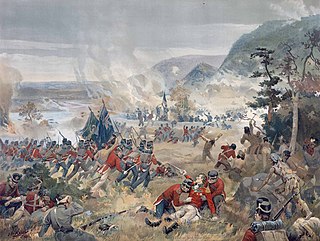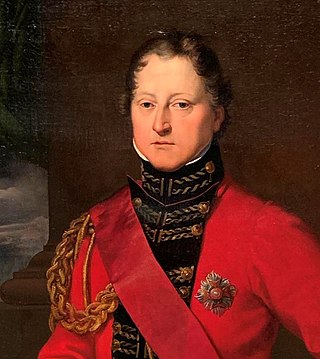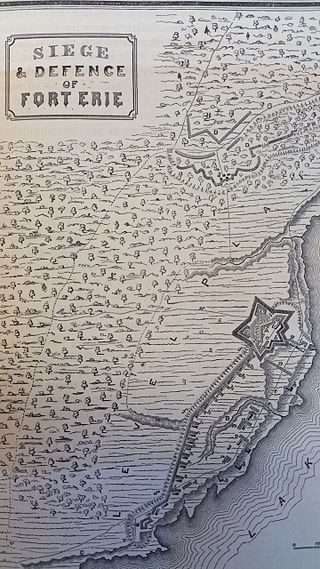
The Battle of Queenston Heights was the first major battle in the War of 1812. Resulting in a British victory, it took place on 13 October 1812 near Queenston, Upper Canada.
The Battle of York was a War of 1812 battle fought in York, Upper Canada on April 27, 1813. An American force supported by a naval flotilla landed on the lakeshore to the west and advanced against the town, which was defended by an outnumbered force of regulars, militia and Ojibwe natives under the overall command of Major General Roger Hale Sheaffe, the Lieutenant Governor of Upper Canada.

The Battle of Lundy's Lane, also known as the Battle of Niagara, was a battle fought on 25 July 1814, during the War of 1812, between an invading American army and a British and Canadian army near present-day Niagara Falls, Ontario. It was one of the bloodiest battles of the war, and one of the deadliest battles fought in Canada, with approximately 1,720 casualties including 258 killed.

General Sir Gordon Drummond, GCB was a Canadian-born British Army officer and the first official to command the military and the civil government of Canada. As Lieutenant Governor of Upper Canada, Drummond distinguished himself on the Niagara front in the War of 1812 and later became Governor-General and Administrator of Canada.

The Battle of Chippawa, also known as the Battle of Chippewa, was a victory for the United States Army in the War of 1812, during its invasion on July 5, 1814, of the British Empire's colony of Upper Canada along the Niagara River. This battle and the subsequent Battle of Lundy's Lane demonstrated that trained American troops could hold their own against British regulars. The battlefield is preserved as a National Historic Site of Canada.

The Capture of Fort Erie by American forces in 1814 was a battle in the War of 1812 between the United Kingdom and the United States. The British garrison was outnumbered but surrendered prematurely, in the view of British commanders.

The siege of Fort Erie, also known as the Battle of Erie, from 4 August to 21 September 1814, was one of the last engagements of the War of 1812, between British and American forces. It took place during the Niagara campaign, and the Americans successfully defended Fort Erie against a British army. During the siege, the British suffered high casualties in a failed storming attempt; they also suffered casualties from sickness and exposure in their rough encampments. Unaware that the British were about to abandon the siege, the American garrison launched a sortie to destroy the British siege batteries, during which both sides again suffered high losses.

The Battle of Fort George was a battle fought during the War of 1812, in which the Americans defeated a British force and captured Fort George in Upper Canada. The troops of the United States Army and vessels of the United States Navy cooperated in a very successful amphibious assault, although most of the opposing British force escaped encirclement.

The Battle of Ogdensburg was a battle of the War of 1812. The British gained a victory over the Americans and captured the village of Ogdensburg, New York. Although small in scale, it removed the American threat to British supply lines for the remainder of the war.

The Capture of Fort Niagara took place late in 1813, during the War of 1812 between the United Kingdom and the United States. The American garrison was taken by surprise, and the fort was captured in a night assault by a select force of British regular infantry.

The Battle of Fort Ontario was a partially successful British raid on Fort Ontario and the village of Oswego, New York on May 6, 1814 during the War of 1812.
Joseph Willcocks sometimes spelt Wilcox was a publisher and political figure in Upper Canada. He was elected to the Parliament of Upper Canada in 1807 representing York, 1st Lincoln and Haldimand. He was re-elected twice and frequently opposed government policies. He became disillusioned with Upper Canada after a military rule was introduced to Upper Canada during the War of 1812 and defected to the United States. He was mortally shot on September 4, 1814 at Fort Erie, and buried in Buffalo, New York.

General Sir Phineas Riall, KCH was the British general who succeeded John Vincent as commanding officer of the Niagara Peninsula in Upper Canada during the War of 1812. In 1816, he was appointed Governor of Grenada.

The Battle of Buffalo took place during the War of 1812 on December 30, 1813, in the State of New York, near the Niagara River. The British forces drove off the American defenders and destroyed many buildings and ships. The operation was retaliation for American troops burning the Canadian village of Newark.
The Raid on Black Rock took place during the War of 1812 between the United Kingdom and the United States on 11 July 1813, near the Niagara River in western New York State, USA. The British objective was to capture supplies and equipment from the U.S. military store depot at Black Rock, New York. The raid was a success but the British force suffered substantial casualties as they returned to their landing-point.
The Canadian Volunteers was a unit composed of pro-United States citizens or inhabitants of Upper Canada which fought for the United States of America during the Anglo-American War of 1812.
The Battle of Ball's Farm took place on July 8th, 1813 during The War of 1812. A British and Native force successfully recovered medical supplies they buried on the Chourous farm a few kilometres from Fort George, Ontario. The medicine supplies were buried in the face of an advancing American army. During the recovery an American force of 500 sortied from the occupied Fort George. A small flanking force of 40 was cut off and almost entirely killed or captured.
On July 5, 1813, 34 Canadian militia and 7 British regulars from the 49th Regiment of Foot crossed the Niagara River and raided Fort Schlosser. They took the American garrison of 11 by surprise and captured them along with all the arms and stores.
The capture of HMS Caledonia and HMS Detroit was an action which took place in the Anglo-US portion of the War of 1812.
On January 8, 1814 a contingent of 70 Americans led by General John Swift attacked a group of British soldiers gathering wood a half-mile from Fort Niagara.











